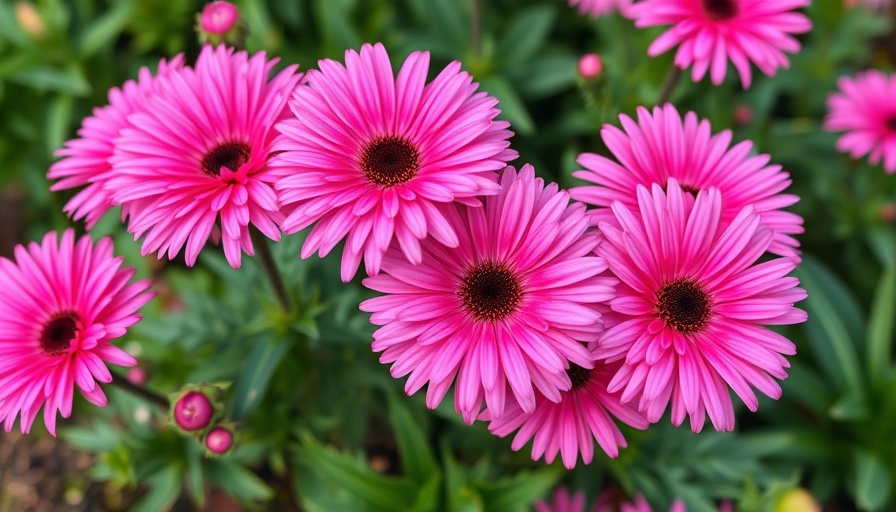
Elevate Your Garden with Stunning Pink Asters
As summer transitions into fall, adding pink aster varieties to your garden can create vibrant floral displays that capture the essence of both seasons. Their cheerful hues not only provide a refreshing visual aesthetic but also harmonize beautifully with other floral colors, enhancing your backyard landscape design. Asters are celebrated for their diverse appearance and resilient nature, making them a perfect choice for gardeners of all levels. Let’s take a closer look at 11 exceptional pink aster varieties that can bring joy and color to your garden.
Understanding Asters: A Floral Family
The term “aster” encompasses various species within the Asteraceae family, with many plants commonly referred to as aster not belonging to the true Aster genus. This family is rich in diversity, featuring plants that vary widely in color, flower structure, foliage, and growth habits. While most asters thrive in full sun and well-draining, nutrient-rich soil, there are exceptions that cater to different growing conditions. Embracing a broad spectrum of genius, asters make a suitable addition to a flower garden or mixed borders.
Key Characteristics of Pink Asters
Pink asters, specifically, exhibit enchanting flower shapes and hues that evoke feelings of warmth and tranquility. Their upright stems make them ideal for back-of-the-border placements, while their moderate to robust growth keeps them looking lush throughout the blooming season. Commonly blooming from late summer to early fall, many varieties also attract pollinators, adding an ecological bonus to your garden space.
11 Stunning Varieties of Pink Asters
- Alma Potschke: This US native perennial, recognizing its roots in New England, boasts showy fuchsia rays with sunny yellow centers. It stands tall at 2.5 to 4 feet and loves well-draining, fertile soil.
- Audrey: A dwarf variety reaching only 12 to 18 inches, this New York native brings pale pink blooms surrounded by a yellow center. It’s perfect for compact spaces and thrives in average moisture.
- Barr’s Pink: Another New England favorite, this cultivar is known for its robust growth and bright flowers, making it a show-stopper in any garden.
- Harrington’s Pink: This variety blooms late and features delicate petals, ideal for layering with other fall bloomers.
- Jewelaster Rose: A unique variety that mesmerizes with its intricate flower structure and vibrant hue, great for attracting butterflies.
- KICKIN® Pink Chiffon: This cultivar is not just a pretty face; it's also disease-resistant, making it a reliable choice for gardeners.
- Milady Rose: With its compact form, Milady Rose creates a stunning visual display while being easy to maintain.
- Pink Zenith: This variety is a favorite among many for its exceptional durability and charm, sure to impress garden visitors.
- September Ruby: This late bloomer extends your garden's color palette into fall with ruby-pink petals.
- Wargrave Variety: Noted for its upright stature and eye-catching flowers, this aster will serve as a lovely focal point in your landscaping.
- Wood’s Pink: A beautifully delicate flower that adds softness to any garden design, perfect for borders and edging.
Designing with Pink Asters
Incorporating these pink aster varieties into your garden offers both aesthetic appeal and practical benefits. Their robust nature allows for placement in various garden designs, whether you're looking to create a butterfly-friendly space or simply want to enhance a flower bed’s visual interest. Consider pairing them with contrasting colors, like whites or purples, for a stunning effect. Garden maintenance becomes easier as these hardy perennials are known for their resilience and disease resistance.
Steps for Successful Aster Growth
To ensure your pink asters thrive, planting them in full sun and rich, moist soil is essential. Regular watering during dry spells and providing fertility through organic methods, like composting, can promote healthier growth and vibrant blooms. Additionally, pinching back the plants mid-summer will encourage bushier growth and more flowers, maximizing your springtime preparations. Fertilizing with organic substances tailored for flowering plants will also support strong growth.
Conclusion
Adding pink asters to your garden not only beautifies your outdoor space but also promotes biodiversity by attracting essential pollinators like bees and butterflies. With careful planning and maintenance, these stunning flowers can flourish, providing ongoing joy throughout the seasons. Don’t hesitate to experiment by mixing various aster types or combining them with complementary perennials for a breathtaking garden display. If you’re eager to explore more gardening tips and plant care practices that enhance your outdoor experience, consider subscribing to gardening newsletters or joining local gardening groups.
 Add Row
Add Row  Add
Add 




Write A Comment